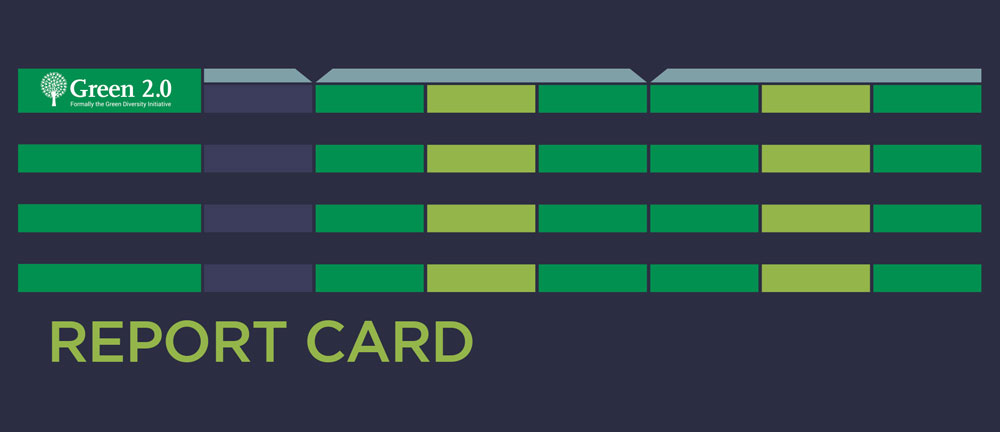
February 5, 2020; Gizmodo
Environmental justice nonprofit Green 2.0 released on Wednesday its third annual report card on how environmental nonprofits and foundations are doing when it comes to hiring and promoting people of color and women.
The lead author for the report is Dr. Stefanie Johnson, a business professor at the University of Colorado, Boulder. For the report, Green 2.0 has also partnered with Candid, which has encouraged voluntary reporting by nonprofits of their board and staff diversity data. The data are self-reported. Some nonprofits report only partial data, and some do not report their board and staff data at all. That said, 36 of the 40 largest environmental organizations did provide at least some data.
Based on this data, Green 2.0 observes that:
Sign up for our free newsletters
Subscribe to NPQ's newsletters to have our top stories delivered directly to your inbox.
By signing up, you agree to our privacy policy and terms of use, and to receive messages from NPQ and our partners.
On average, each of the organizations added 11 people of color to their staff between 2017 and 2019. Among senior staff, organizations added two people of color to their senior staff between 2017 and 2019, but there was no change in the number of women on senior staff. The percent of women and people of color on boards increased as well with organizations adding, on average, one person of color and one woman to their board between 2017 and 2019.
“This is the beginning of progress,” notes Whitney Tome, executive director of Green 2.0. “It is critically important that all these NGOs and foundations are more in tune with the demographics of the United States.”
Helpfully, the report includes data from individual organizations, which gives a sense of the range. Here we reproduce 2019 numbers for what we see as two key categories—board and senior staff—for 31 organizations (five more organizations only reported partial numbers, so are not listed here)
| Board | Senior Staff | |
| American Rivers | 15.4% | 6.3% |
| Blue Green Alliance | 12.5% | 16.7% |
| Center for International Environmental Law | 44.4% | 33.3% |
| Center of Biological Diversity | 20% | 7.6% |
| Clean Water Action | 16.7% | 0% |
| Defenders of Wildlife | 7.1% | 21.4% |
| Earth Justice | 23.5% | 37.5% |
| Energy Foundation | 12.5% | 32.2% |
| Environmental Defense Fund | 12.8% | 15% |
| Friends of the Earth | 29.4% | 20% |
| Green for All | 66.7% | 50% |
| Greenpeace | 42.9% | 22.2% |
| League of Conservation Voters | 21.4% | 18.2% |
| National Audubon Society | 26.5% | 14.3% |
| National Fish and Wildlife Foundation | 56% | 58.3% |
| National Parks Conservation Association | 42.9% | 22.2% |
| Ocean Conservancy | 0% | 0% |
| Partnership Project | 0% | 0% |
| Population Action International | 38.5% | 40% |
| Rainforest Action Network | 25% | 30% |
| Resource Media | 27.3% | 16.7% |
| Resources Legacy Fund | 18.2% | 25% |
| River Network | 23.5% | 0% |
| Sierra Club | 20% | 17.9% |
| The Nature Conservancy | 27.3% | 13.7% |
| Trust for Public Land | 4.8% | 20.5% |
| Wilderness Society | 14.3% | 7.4% |
| World Resources Institute | 29.6% | 32.4% |
| Union of Concerned Scientists | 16.7% | 9.1% |
| US Climate Action Network | 25% | 100% |
| World Wildlife Fund | 17.4% | 17.6% |
A couple notes of caution are in order. Dorceta Taylor, a professor at the University of Michigan and author of the first Green 2.0 report in 2014, tells Yessenia Funes of Gizmodo that the numbers are lower for people of color at small and midsized environmental organizations, so the presence of people of color at the senior staff and board level of environmental organizations overall may still trail already dismal overall nonprofit sector numbers.Still, these medians are somewhat better than the numbers reporting by BoardSource for the sector as a whole. BoardSource reports on CEOs, not senior staff, but found that only 10 percent of CEOs were people of color in 2017; as for board membership, BoardSource found that only 16 percent of nonprofit board members surveyed were people of color.In terms of median numbers, for the above 31 organizations, the median board percentage of people of color was 21.4 percent. The median senior staff percentage was 18.2 percent. At present, the percentage of people of color in the US population is 39.6 percent. Clearly, a large representation gap persists.
Another caution is that the gains in diversity at the larger organizations are recent and not yet institutionalized. Tome tells Funes that she is “cautiously optimistic” but points out that whether the commitment to inclusion is long-term has yet to be tested. “That’s one thing to make very, very clear: There is still a lot of work to be done.”—Steve Dubb













